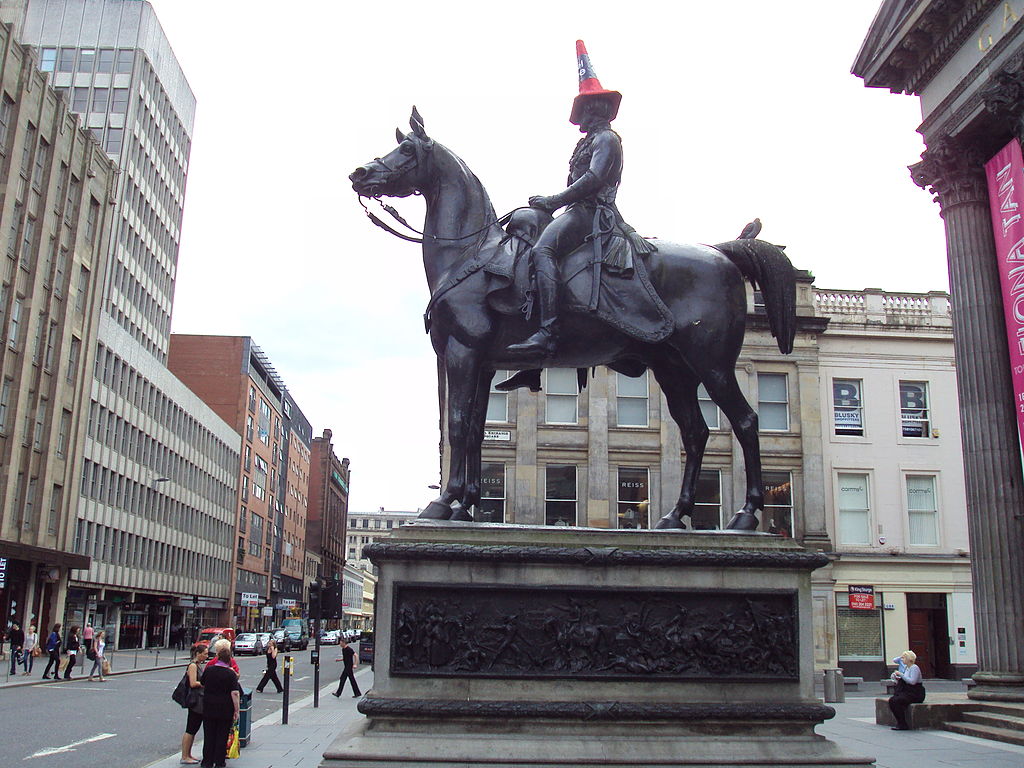The Statue in Glasgow with a Traffic Cone on Its Head — Sometimes

Pictured above is a statue of the Duke of Wellington, one of many throughout the United Kingdom. This particular one is in Glasgow, just outside the Gallery of Modern Art. And if you’re familiar with it, you already know that something is amiss — or, more accurately, something is missing. Namely, his hat, as seen below.

Yes, that’s an orange traffic cone.
The pictured statue was built in 1844, honoring Arthur Wellesley, 1st Duke of Wellington, the two-time Prime Minister who was also the field marshall who defeated Napoleon at Waterloo. And for more than a century, it remained unbothered. But starting in the 1980s or thereabouts, the statue found itself home to a new tradition: residents of Glasgow would regularly place the cone atop the Duke’s head, ostensibly as a testament to the Scottish sense of humor. Over the years, the conical hat has become a part of the local culture; for example, in celebration of Glasgow’s hosting of the 2014 Commonwealth Games, a pair of statue-climbers took down the orange cone and replaced it with a gold-painted one, as seen in this video. It seems like a harmless little prank, one that shouldn’t provoke the ire of police or other government officials.
But the powers-that-be-in Glasgow didn’t take too kindly to the cone-ification of a local landmark. In 2005, for example, the BBC reported that “the Duke has lost his spurs and half his sword as a result of pranksters trying to scale the structure,” and as a result Glasgow officials announced that placing a cone on the statue would be considered a “criminal act” (vandalism, specifically) and be treated accordingly. That didn’t stop the cones, though. So in late 2013, after spending a reported £10,000 removing cones annually (100 removals at about £100 per, which seems rather high), Glasgow decided enough was enough. The solution? At the cost of £65,000, the city was going to raise the base of the statue by about six feet (and replace the sword), making it very hard for would-be cone-toppers to reach the Duke’s head.
The people fought back, and immediately. News of the city’s plans hit the press on November 11, 2013 (warning: that link auto-plays a video) and, nearly immediately, townsfolk petitioned the city council to reverse that decision. The petition reached 10,000 signatures in under 24 hours, and the city capitulated shortly thereafter. On November 12th, the city council dropped the renovation plans. So if you go by the statue today, there’s a good chance Wellington will have a cone on his head.
 Bonus Fact: For reasons unclear, residents of Glasgow have a significantly lower life expectancy than other people in the UK. For women, the national average life expectancy is 82.3 years, but for Glaswegians, it’s 78 years. For men, the national average is 78.2 years, but Glasgow’s men live to be, on average, 71.6. As the Economist observed, the lack of explanation has provided invitation for anyone with a pet issue to use Glasgow as an example of culture run amok: “people attribute the city’s alarmingly high mortality rate to whatever they find most troubling about Britain.”
Bonus Fact: For reasons unclear, residents of Glasgow have a significantly lower life expectancy than other people in the UK. For women, the national average life expectancy is 82.3 years, but for Glaswegians, it’s 78 years. For men, the national average is 78.2 years, but Glasgow’s men live to be, on average, 71.6. As the Economist observed, the lack of explanation has provided invitation for anyone with a pet issue to use Glasgow as an example of culture run amok: “people attribute the city’s alarmingly high mortality rate to whatever they find most troubling about Britain.”
Take the Quiz!: Let’s talk ice cream cones. (This will make even more sense when you hit the “From the Archives” link, below.) Can you name Baskin-Robbins’ original 31 flavors?
From the Archives: Ice Cream, You Scream: Glasgow’s Ice Cream Wars.
Related: A hat for a statue.
